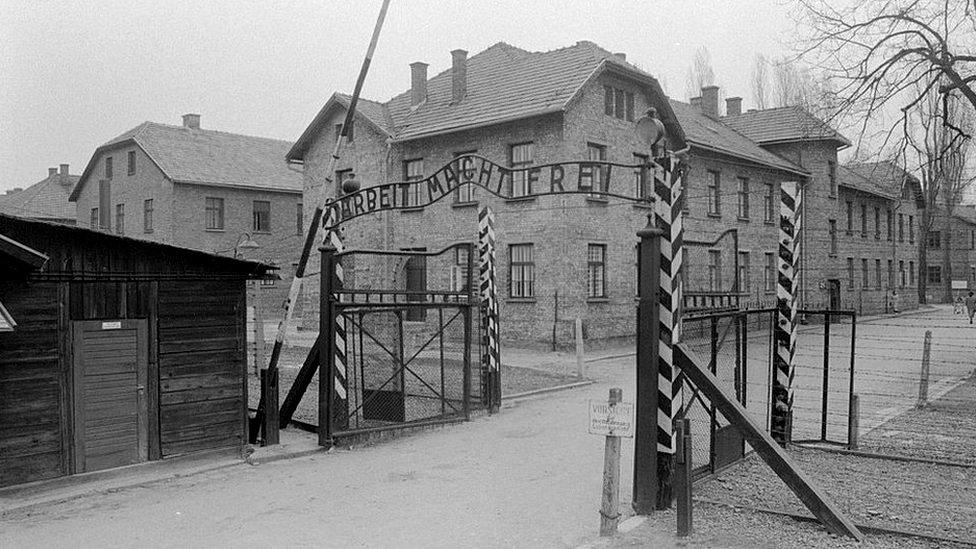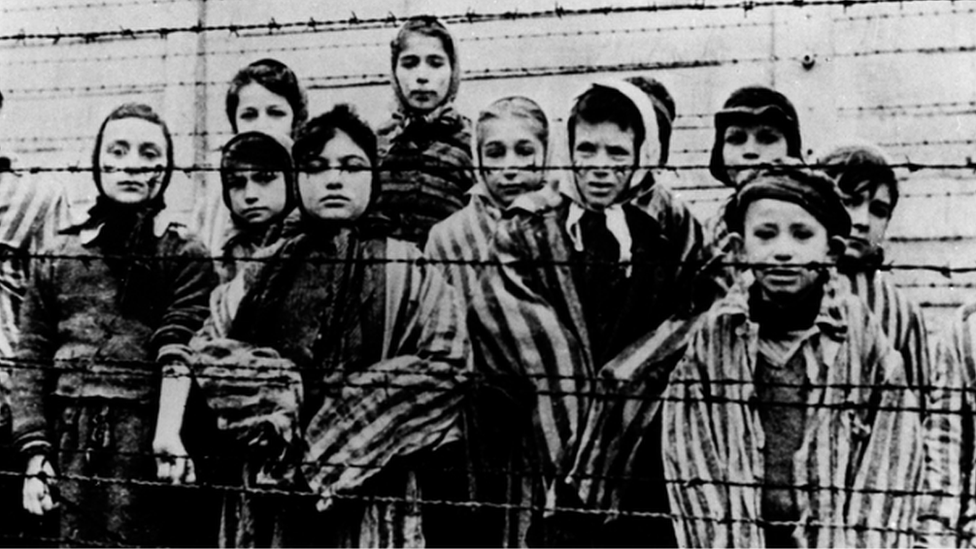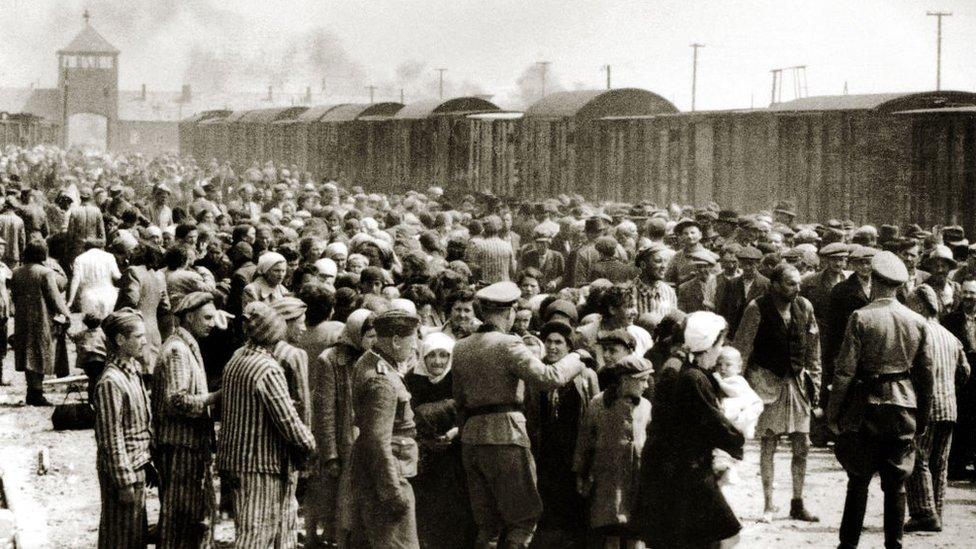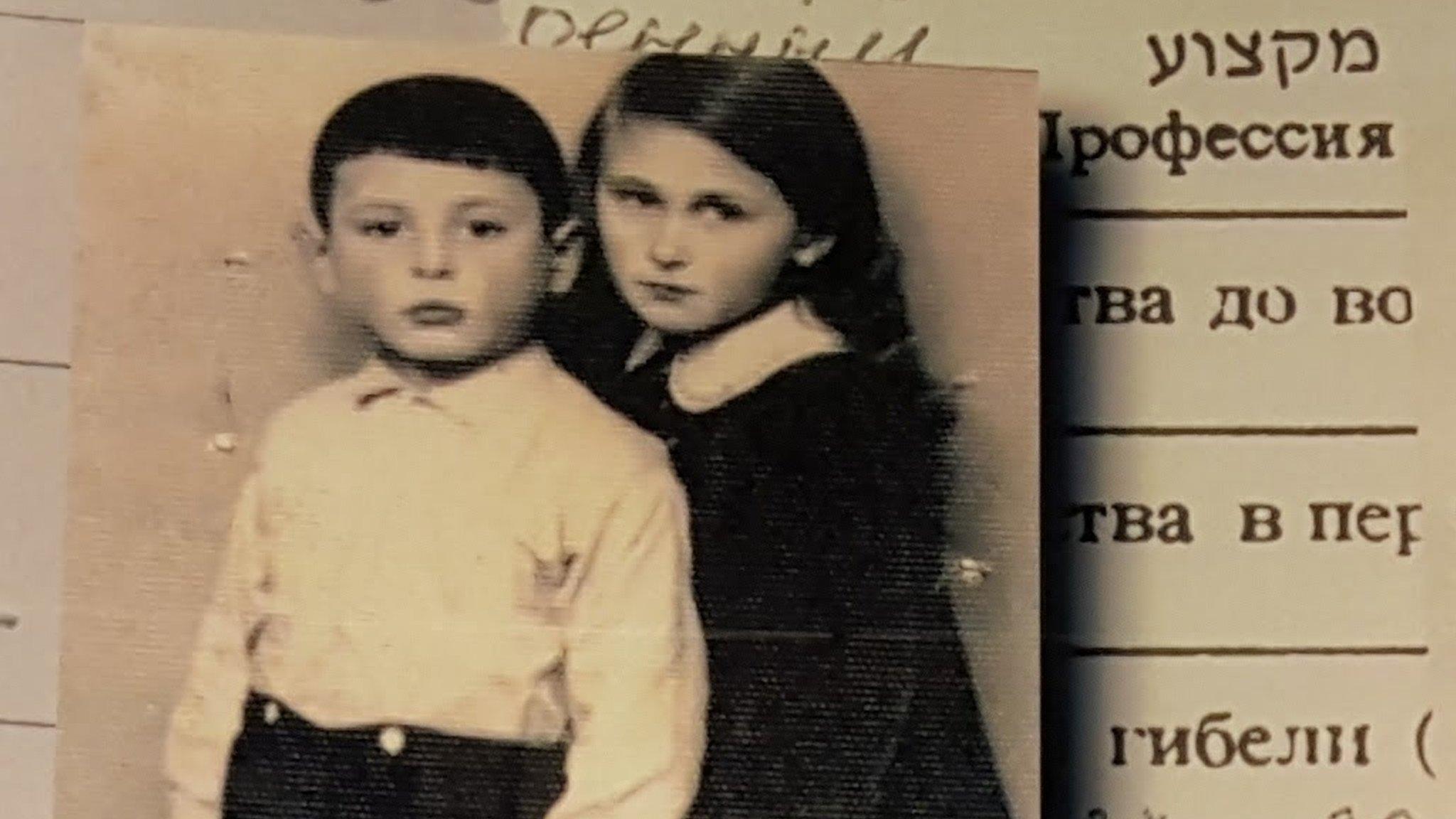Auschwitz survivor: 'There was no life. We were starving'
- Published
Auschwitz survivor: 'I couldn't even say cheerio'
Scotland's last Auschwitz survivor has recalled the horror of the Nazi death camp as the 75th anniversary of its liberation is marked.
Judith Rosenberg was 22 when she was put on a cramped train with her Jewish family in the spring of 1944.
Together they were transported from Gyor in their native Hungary to Poland where they were immediately split up.
Ms Rosenberg, now 97, recalled: "I could not even say cheerio to my father."
Although she never saw her father again, Ms Rosenberg held on to a piece of advice the timber merchant, Zsigmond, had given her.
About 1.1 million people, mostly Jews, were murdered at Auschwitz-Birkenau during the Holocaust.
Gas chambers
Ms Rosenberg told BBC Scotland: "When the Germans ask what to do always take the one that is most difficult to do because the Germans are like that.
"They say there is a bus waiting for you or you walk.
"Always take the walk because the bus, I was told afterwards, took them straight to the gas chambers."

The daily rations at Auschwitz were a cup of water and a bread roll
After arriving at Auschwitz, Ms Rosenberg said the family were taken to barracks where they were ordered to strip naked.
The prisoners' head and body hair was then shaved and they were told to put on red and white prison-style uniforms.
She added: "We just looked at each other and we did not believe. What could we do?"
In the months that followed, they endured daily roll calls, during which they came face-to-face with the notorious Josef Mengele, known as the Angel of Death.
Ms Rosenberg said: "We stood in a line of five and were counted.
"I don't know why they were counting us because nobody could escape."
Auschwitz: Drone footage from Nazi concentration camp
Asked about the conditions, she said: "There was no life. We were starving.
"Every day we had a little cup of water and one roll.
"We only starved for about half a year but it is amazing that you lose so much weight."
In September 1944, Ms Rosenberg was put on a train to Lippstadt in Germany where she was ordered to work in a munitions factory.
The following spring she was ordered to march out into the countryside with a party that included her mother and sister.
'Wonderful wedding'
SS guards told the group they had to head further into Germany as the Americans were advancing.
Ms Rosenberg said: "They said 'Just rest here'.
"We looked up and somebody said: 'The SS has gone.'"
The group soon encountered American soldiers who had secured an abandoned town where the prisoners experienced the luxury of a proper bed.
Ms Rosenberg soon got a job as a British military interpreter and fell in love with Scottish artillery officer Harold Rosenberg.

Jewish children from all over Europe were transported to Auschwitz
After he secured the personal approval of Field Marshall Bernard Montgomery, the couple were married in Warburg, Germany.
A US military unit sourced "at least 100 bottles of champagne" for the celebration.
Ms Rosenberg recalled: "Everybody in the village was drunk. Everybody was singing. It was a wonderful wedding."
The couple later moved to Glasgow where they were were surprised by the scale of post-war rationing.
She said: "We did not get nearly enough food as we did in Germany."
Despite her experiences, Ms Rosenberg does not feel any animosity.
She said: "You can't blame everybody forever."

What was the Holocaust?
When the Nazis came to power in 1933 they began to strip Jewish people of all property, freedoms and rights under the law. After the German invasion and occupation of Poland in 1939, the Nazis started deporting Jewish people from the Third Reich to parts of Poland, where they created ghettos to separate them from the rest of the population.
In 1941, during the German invasion of the USSR, the Nazis began their campaign of extermination in earnest. Nazis spoke about their invasion as a race war between Germany and Jewish people, as well as the Slavic population and the Roma.
Explaining the Holocaust to young people
Groups of German soldiers called Einsatzgruppen set out across newly-conquered lands in Eastern Europe to massacre civilians. By the end of 1941, they had killed 500,000 people, and by 1945 they had murdered about two million - 1.3 million of whom were Jewish.
Behind the lines, Nazi commanders were experimenting with ways to kill en masse. They feared that shooting people was too stressful for their soldiers, and so came up with more efficient means of murder.
Experimental gas vans had been used to kill mentally disabled people in Poland as early as 1939. Poisonous fumes were pumped into a sealed compartment to suffocate those inside. By the winter of 1941, the Nazis had constructed gas chambers at Auschwitz.
Nazi leaders met in January 1942 at the Wannsee Conference to co-ordinate the industrial slaughter - what they called a "final solution to the Jewish question" - killing the entire European Jewish population, 11 million people, by extermination and forced labour.
- Published27 January

- Published24 April 2017
